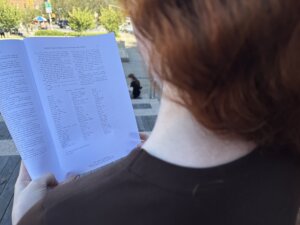Features
60 years plus one – since the first Ramah Hebrew School graduating class… and counting
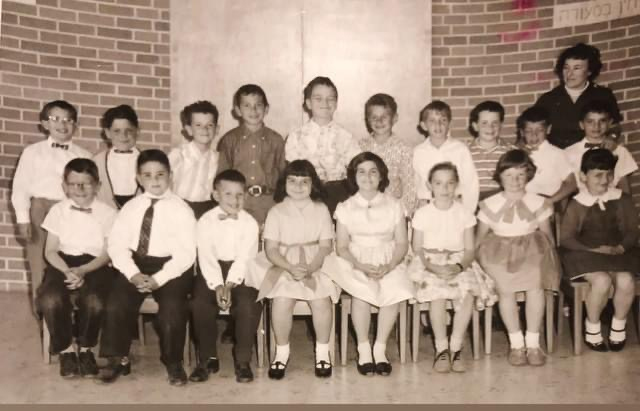
(August 2025) Submitted by Martin A. Koyle (Denver, Colorado), Judy L. (Shenkarow) Pollock (San Diego, California), and Lorne Billinkoff (Winnipeg, Manitoba)
It is now a year since the three of us had a unique opportunity to reconvene with 11 other septuagenarians to share memories of an event that occurred 60 years ago. In August 2024, 14 graduates of the inaugural class of 16 students at Shaarey Zedek Hebrew Day School, which ultimately became Ramah Hebrew School and later, part of Gray Academy, met to celebrate our graduation in 1964.
Many of our families had migrated to the River Heights area (when there were no Mathers or Taylor Avenues) from the North End, where the Talmud Torah and Joseph Wolinsky Collegiate were foundations in that established community. None of us have any idea how the first “South End” Jewish school was conceived or funded, but we credited our parents, who had the “sechel” and belief that we, as Grade 2 students, would essentially be guinea pigs in the founding of a parochial, half-day English, half-day Hebrew school in that growing area of Winnipeg.
All of us had been in the Winnipeg Public School system prior to that radical shift, but we had also attended evening school at Shaarey Zedek Synagogue on Wellington Crescent and Academy Road where, like other students, we enjoyed chocolate milk, shortbread cookies and Wagon Wheels, along with friendship with the caretakers, Steve and Metro.
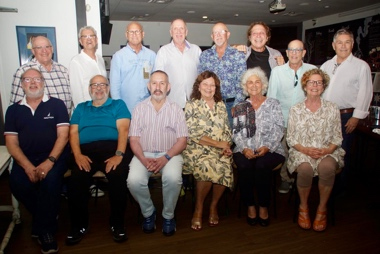
Top Row (L-R): Harold Steiman, Brian Sharfstein, Ken Wolch, Marty Koyle, Peter Mendelsohn, David Goldstein, Ted Rosenstock, Howie Wiseman
Bottom Row: Lorne Billinkoff, Stephen Plotkin, Sam Miller, Maureen Shafer, Judy Shenkarow, Ruth Lehmann
Of the 14 former students of that first Shaarey Zedek Day School class who attended last year’s reunion, there were representatives from California, Colorado, Florida, Toronto, and Vancouver, along with those who had remained in Winnipeg.
The first night we convened at the Tuxedo home of Ashley Leibl (who had joined our class in Grade 3). Of course, Winnipeg style delicatessen was served in abundance. The next evening, along with significant others, friends and their spouses, we shared a dinner at Alena Rustic Italian Restaurant in Charleswood, after being given a tour of what was then the renovating Shaarey Zedek Synagogue.
Judy Shenkarow hosted a post-Winnipeg get together in her family cottage on Prospect in Winnipeg Beach (which has belonged to generations of her family), and which she continues to enjoy despite the long drive each year from San Diego – and in a Tesla no less!
Throughout our all too brief time with one another, we reminisced about stories of our English teachers: Mrs. Smith, Mrs. Beckett, Mrs. Tallboom, and Mr. Lightbody; also our Israeli Hebrew teachers: Mrs. Lachter, and husband and wife couples: the Wernicks, Kamils, and Dafnais.
We were fortunate to also have had Myer Silverman as our principal throughout our five years as students. The esteemed (and beloved by us) educator Morag Harpley, previously the Supervisor of Primary Grades in the Winnipeg School Division, joined the administration in 1963 as Supervisor and Chief Consultant.
The brand-new Shaarey Zedek School, as it was first known, was constructed on land at the corner of Lanark and Grant and was quite a distance from the synagogue. I doubt that any adult today would let their kids play anywhere close to the swamps that were part of the school grounds at that time. We, however, took twigs and branches and old building materials left over from the school construction, to build forts and dams and to play games of war, while wearing high rubber boots and water proof pants, frequently returning after recesses soaking wet.
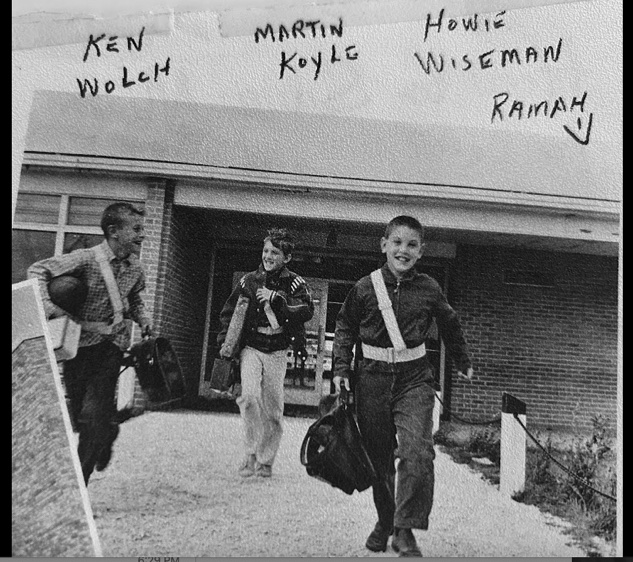
As new classes were enrolled, we were always the most senior class. Given this seniority, we were given the responsibility of being appointed the first safety patrols, posts which we held for the entire five years we were there. During those five years, we lost a few initial students, but gained others. As we entered Grade 5, Shaarey Zedek merged with Herzlia Academy Day School and the name was changed to Ramah Hebrew School. By the time our class reached Grade 6, the enrollment in our grade had become large enough to mandate splitting us into two classrooms.
Our education had added value on the occasional weekends when some of the fathers would host learning weekend events where we went to offices or homes, learned how to take X-rays, listen to a heart or, in a chemistry lab – make copper sulfate crystals.
Some of us were driven or car-pooled by our parents while others took public transit, or had arrangements made to take taxis back and forth. In those days, you could buy five public bus tickets for 30 cents. Ted Rosenstock’s mother, Lottie, actually petitioned Winnipeg Transit and the City of Winnipeg to expand the Grant bus service beyond the railway tracks, which at that time only extended to Borebank. Lottie pointed out the potential dangers of young children having to cross the tracks and walk all the way to Lanark!
Some of us who lived not far from Grant became more industrious as we got older and would walk back and forth, rather than take the bus. This allowed us to save those bus fare pennies and stop at Irving Klasser’s Niagara Drugs to buy chocolate bars, which were only 10 cents back then.
Since distances and transportation made lunchtime impossible for most of us to return home, most of us had packed lunches, which we often shared. Myer’s Delicatessen was the only eatery close by, and it was a treat to have Chicago Kosher (RIP) products for lunch at the small counter there as an occasional treat.
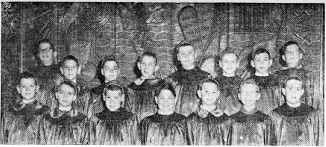
Perhaps a unique requirement to the English and Hebrew education we received was that we were required to attend synagogue services as a religious component of our studies. The Shacharit services at the Shaarey Zedek were led by us every Saturday as the Junior Choir, directed by Jack Garland from Grade 2 and all the way through our B’nai Mitzvot dates in 1964/1965. By those years we had all matriculated back into the Winnipeg Public School System.
Despite our somewhat cloistered environment for the five years at Ramah, we assimilated without difficulty into the public school systems, principally at Grant Park and River Heights.
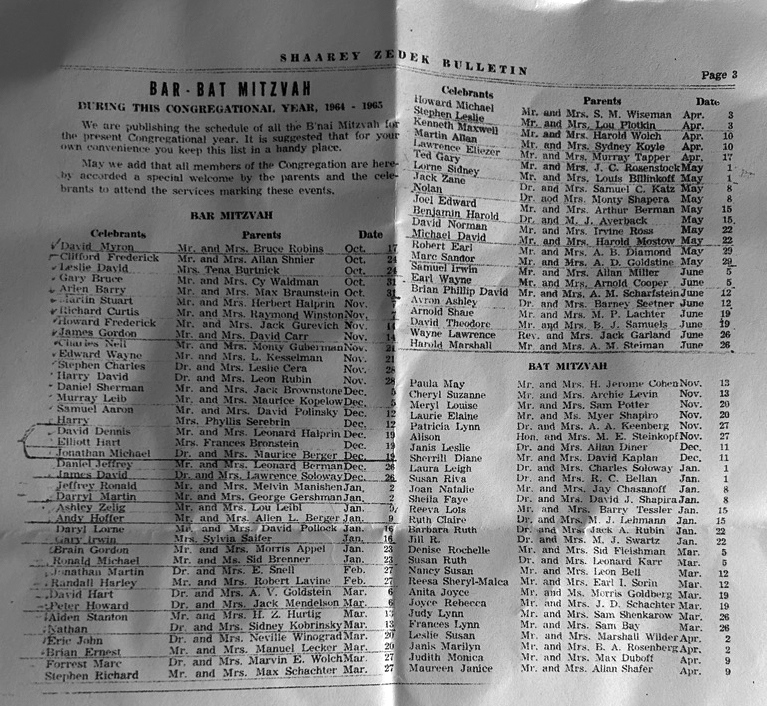
Despite the challenges of having to participate in Saturday services for those five years, we gained many benefits from working closely with Shaarey Zedek Cantor Rabbi Louis Berkal, along with then-Rabbi Milton Aron. Given the plethora of baby boomers from our generation and not enough Shabbats in 1964-1965 to allow us to celebrate our Bar or Bat Mitzvot individually, we coordinated these events as pairs, usually with our fellow Ramah classmates.
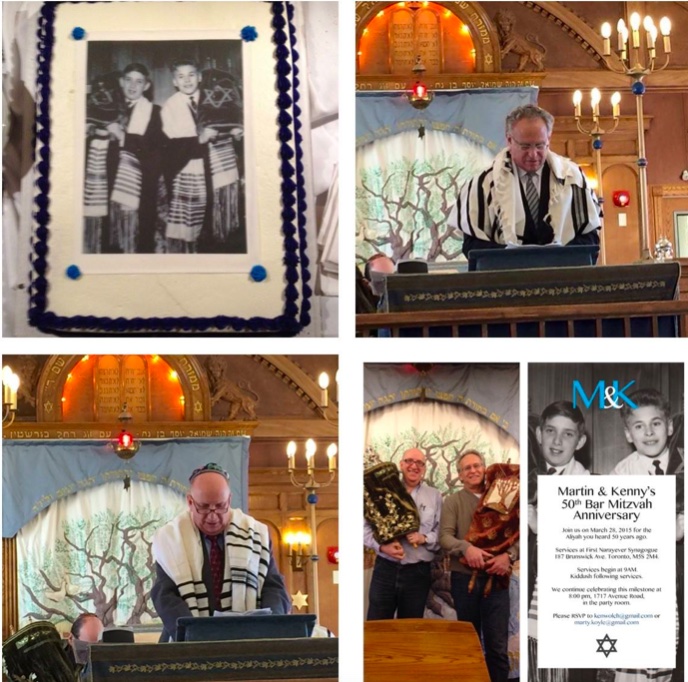
In 2015, in Toronto, Kenny Wolch and Marty Koyle re-recited their 1965 Haftorahs at Narayver Synagogue, with the same tropes that Jack Garland had taught them. No less than 28 Winnipegers attended the simcha.

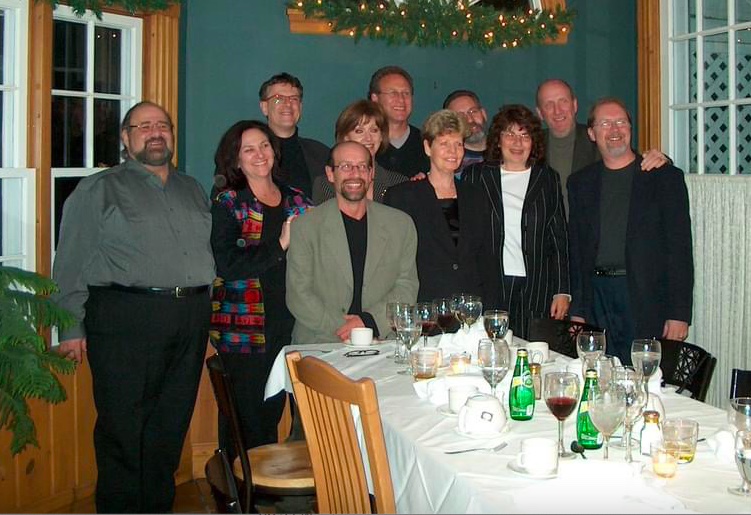
Importantly, through our five years together, we became a community of lifelong friends. We had met previously in Winnipeg in 2004 to celebrate the 40th anniversary of our graduation at a time where some surviving parents were still able to join us.
The warmth and sense of “mischpochah” thrives now into its seventh decade. We still marvel at how our parents and the Shaarey Zedek had the vision and faith that led to these foundations. Classmate Harold Steinman (Vancouver), whom most of us had not seen since high school, summed up our reunion appropriately, stating that it “filled a void in my heart!”
Features
Bitcoin Price Volatility: WOA Crypto – Why Cloud Mining Becomes a Safe Haven for Investors

(Posted Oct. 10, 2025) Bitcoin once again attracted market attention today, with the price around $122,259, with an intraday high of $124,138 and a low of $121,141. Driven by capital flows, ETF inflows, and macroeconomic factors, Bitcoin recently hit a new high, but encountered retracement pressure today and fluctuated widely between $121,000 and $124,000 during the initial decline.
There have been no major structural changes in capital flows. For most investors, the best way to deal with volatility is not to try to precisely time peaks and troughs, but to let assets generate returns both in the ups and downs.
Cloud Mining: A New Approach Beyond “Observing the Charts”
In a constantly volatile market, checking charts, chasing peaks (and then cutting losses) is routine—actions that often lead to emotional exhaustion and poor decision-making. Cloud mining offers a solid, rules-based revenue model.
What is cloud mining?
Cloud mining allows you to mine Bitcoin and other altcoins without having to purchase, manage, or maintain any mining hardware. Simply invest your digital assets (e.g., BTC, ETH, XRP, USDT), and the platform will provide you with the computing power and handle all technical issues. Yes, the system will mine for you and pay you daily.
To summarize: you invest cash, the platform provides computing power, and your time pays off.
During periods of high prices and volatility, cloud mining (due to its daily payouts and weak correlation with price fluctuations) attracts more rational investors.
WOA Crypto Mining: Making Cloud Mining Practical
Among the many cloud mining services, WOA Crypto positions itself as a simple, secure, and transparent service—allowing investors to focus on more than just price monitoring.
Key highlights of WOA Crypto
Zero technical barriers: No hardware setup or maintenance required.
Daily payouts: Profits are automatically settled every 24 hours, ensuring a stable cash flow.
Multi-asset support: Accepts BTC, ETH, XRP, and USDT.
Transparent and secure system: Clear rules, an open profit structure, and a proven withdrawal mechanism.
Green energy and global deployment: Using efficient computing centers powered by renewable energy to increase stability and reduce costs
How to start your WOA Crypto mining journey
Visit the official WOA Crypto website.
Register using your email address and create a password.
Simply deposit BTC, ETH, XRP, or USDT, and your funds will be converted into computing power.
Choose a mining contract plan and start earning your first profit within 24 hours.
No technical knowledge or hardware required, no need to follow market trends: this simple-to-use app will give you a comfortable home cloud mining experience. Click here to get started.
Conclusion: Finding stability amidst volatility
While the price of Bitcoin has fluctuated between $121,000 and $124,000, the winners haven’t been those who perfectly timed the tops and bottoms, but rather those who consistently let the asset perform.
Cloud mining eliminates most of the emotional fluctuations in trading and provides a strategy that is easy to accumulate over the long term, which can continue to accumulate capital even in uncertain times. In times of market volatility, letting assets grow in value is undoubtedly the most resilient investment strategy.
Official email: info@woacrypto.com
Features
Beyond Pusoy and Tongits: A Look at GameZone’s Exclusive Gaming Portfolio

For generations, Tongits and Pusoy have stood as cornerstones of Filipino gaming culture. These games transcend mere pastime; they are social rituals—played during birthdays, family reunions, and even the quiet nights of a lamay.
Each hand dealt carries a blend of laughter, banter, and skill, weaving together community and camaraderie.
Yet as the Filipino way of life becomes increasingly digital, traditional card games are evolving. Platforms like GameZone Philippines have taken up the mantle of preserving this heritage while pushing it forward.
Through its exclusive lineup of innovative titles, GameZone bridges the past and the future, offering a selection of games that celebrate the Filipino gaming spirit while embracing modernity.
Beyond the familiar cards of Tongits and Pusoy, GameZone exclusive games represent a new chapter in online entertainment—one defined by variety, quality, and distinctly Filipino ingenuity.
GameZone Exclusive Games: The New Standard of Digital Play
While Tongits and Pusoy remain at the heart of the GameZone experience, the platform’s exclusive gaming portfolio expands far beyond them.
These titles embody both creativity and technical precision, providing fresh gameplay experiences that suit every mood—from strategic planning to fast-paced reflex challenges.
Below are six of the most notable GameZone exclusive games that exemplify this new wave of Filipino digital entertainment.
1. Tongits Joker: A Reinvention of a Classic
In the hierarchy of Filipino card games, Tongits reigns supreme. But GameZone’s Tongits Joker brings a compelling innovation to this beloved classic.
The addition of the Joker card injects a new level of unpredictability into each round, allowing it to function as a wildcard that can transform the tide of play.
Players can now form unique combinations, such as the elusive five-of-a-kind, while testing their ability to think ahead and adapt in real time.
This heightened complexity introduces a more dynamic experience—balancing luck, logic, and creativity.
Tongits Joker honors the original’s community-based spirit while challenging players to reimagine their strategies.
It is both a tribute to Filipino tradition and a step toward a more competitive and intellectually engaging future for local gaming.
2. Mines+: The Pursuit of Precision
While many online games lean on chance, Mines+ rewards observation, calculation, and the courage to take measured risks.
Drawing inspiration from the classic minesweeper concept, this GameZone exclusive enhances the experience through refined visuals, intuitive gameplay, and a structure that prioritizes precision over luck.
Each click becomes a strategic decision—an interplay between instinct and logic. One mistake can end a run, yet each victory feels earned through sheer focus.
Mines+ encapsulates the essence of mental discipline, offering a simple yet sophisticated game that appeals to players who appreciate mastery over fortune.
3. Ultra Ace: Where Speed Meets Skill
Modern gaming thrives on immediacy, and Ultra Ace delivers precisely that. This fast-paced card-based competition challenges players to think and react under pressure, rewarding sharp timing and accuracy.
Every round becomes a test of reflex and reason as players chase the elusive “Ultra Ace” hand—the perfect combination that guarantees victory.
The game’s minimalistic design ensures focus remains on the action, while its competitive environment captures the spirit of Filipino resilience and determination.
Ultra Ace exemplifies GameZone’s approach: offering entertainment that is not only thrilling but also deeply skill-oriented. It invites players to refine their instincts while enjoying the exhilaration of quick, decisive play.
4. Candy Rush: Simplicity Refined
At the lighter end of the spectrum lies Candy Rush, a game designed to soothe rather than stress. Despite its charming aesthetic and simple mechanics, it is far from ordinary.
Players engage in an endless rhythm of matching and scoring, each round inviting a satisfying sense of progression. Its accessible gameplay ensures it can be enjoyed by all ages, while its clever design keeps engagement high even during short breaks.
More than just a casual diversion, Candy Rush demonstrates GameZone’s understanding of player psychology. It balances challenge and comfort, ensuring that gaming remains a pleasurable escape rather than a test of endurance.
By stepping beyond card-based mechanics, GameZone showcases its versatility, proving it can craft experiences that entertain across genres while maintaining polish and playability.
5. Lucky Hilo: Strategy in Simplicity
At first glance, Lucky Hilo appears deceptively straightforward: predict whether the next card or number will be higher or lower. Yet beneath that simplicity lies a complex interplay of intuition and statistical reasoning.
GameZone’s refined interface and brisk pacing elevate Lucky Hilo into something more strategic and rewarding than chance alone. Each decision tests a player’s understanding of probability and pattern recognition, encouraging thoughtful play over reckless guessing.
It’s a game of instinct—but also of restraint. And that balance between gut feeling and smart calculation makes Lucky Hilo a standout among GameZone’s exclusive offerings.
6. Super Gems: The Pressure of Precision
In contrast to Candy Rush’s calm charm, Super Gems thrives on intensity. The game demands that players match colorful gems under strict time limits, transforming each session into a contest of focus and reflexes.
Every second counts. The ticking clock heightens tension, rewarding quick thinking and composure under pressure. Yet beneath that adrenaline rush lies an elegant design—proof that competitive play can be both thrilling and aesthetically pleasing.
Through Super Gems, GameZone delivers a polished arcade-style experience that merges strategy with spectacle, further diversifying its gaming catalog.
About GameZone Philippines
GameZone Philippines is a premier online entertainment platform that redefines digital gaming for Filipino audiences.
With a deep respect for local culture and an eye toward technological innovation, GameZone curates a library of skill-based, interactive, and socially engaging titles that mirror the vibrancy and wit of Filipino gamers.
The platform’s commitment to quality and creativity has established it as a leader in the Philippine gaming landscape.
Each of its exclusive titles—whether rooted in tradition or exploring new frontiers—underscores a dedication to community, fairness, and fun.
GameZone also prioritizes accessibility, ensuring that players of all backgrounds can participate and connect through shared experiences.
Its games foster friendly competition, mental engagement, and social connection, embodying the true spirit of Filipino gaming: inclusive, inventive, and endlessly entertaining.
Beyond recreation, GameZone’s mission extends to community-building. It aims to strengthen the digital bonds among Filipino players worldwide by providing a safe, enjoyable, and skill-oriented gaming environment.
Redefining Filipino Gaming in the Digital Era
The GameZone exclusive games discussed here symbolize a broader cultural shift. Where once the nation’s gamers gathered around tables and decks of cards, they now connect across screens and servers—united by nostalgia, skill, and innovation.
These titles represent not just entertainment but evolution. They reaffirm that Filipino gaming is alive, adaptive, and forward-looking.
From the strategic depth of Tongits Joker to the casual charm of Candy Rush, every game reflects GameZone’s vision of blending tradition with technology.
In essence, GameZone is more than a platform; it is a movement to reimagine Filipino play for the modern age.
By offering diverse experiences that balance challenge, creativity, and cultural identity, it ensures that the joy of gaming remains a shared and enduring part of Filipino life.
So the next time you log in, look beyond Pusoy and Tongits. Explore GameZone’s exclusive portfolio—and discover how the future of Filipino gaming continues to evolve, one expertly crafted game at a time.
Features
With Gaza War Ending, Where Does Jordan Stand?
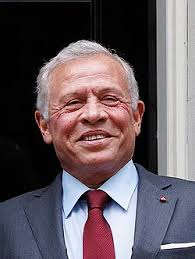
By HENRY SREBRNIK Today’s “two-state solution” for the pre-1948 Palestine Mandate governed by the United Kingdom is an offshoot of the older idea of partition: the division of the land into Jewish and Arab countries. Transjordan, as it was then called, had been cut from the original Mandate in 1921 and became, first, a separate British mandate under an emir, and in 1946, as Britain was on the verge of leaving Palestine, the Hashemite Kingdom of Jordan. It was always a fragile creation, yet it has lasted to this day, often defying predictions of its imminent demise by friends and foes alike.
Some analysts are currently floating another old idea. Given the basic instability and unsustainability of any Palestinian state in the West Bank (with or without Gaza), a Jordanian-Palestinian confederation comprising the Hashemite Kingdom and the West Bank might, in their eyes, be a better idea.
They view a Jordanian security presence in the West Bank as reliable, more so, certainly, than a Palestinian one. The late King Hussein proposed such a confederation in 1972: a united kingdom consisting of two districts, with full West Bank autonomy except for Jordan’s control of military and security matters and foreign affairs. In 1977, U.S. President Jimmy Carter raised it with Prime Minister Menachem Begin; at various times, President Anwar Sadat of Egypt and U.S. Secretary of State Henry Kissinger espoused the idea.
Indeed, Hussein and PLO president Yasir Arafat agreed to such a confederation in 1985. The king defended this as a “a matter of shared history, experience, culture, economy, and social structure.” Jordan is Arab and Muslim, and already a majority of Jordanian citizens are themselves Palestinian in origin. He believed that the Palestinians would be better served by linking their destiny with Jordan, “a sovereign state which enjoys credible international standing.”
Yet only three years later Jordan renounced the plan, and following the 1993 Oslo Accords, which created a PLO entity in the West Bank, that idea has faded away. Yet it still has some currency, with Palestinian support at times fairly robust. Many Israelis maintain that it would be desirable if the Palestinians became citizens of existing Arab states, Jordan in particular.
But why would Jordan acquiesce to this today? It is true that Jordan controlled the West Bank between 1948 and 1967. But Palestinian national identity back was not as pronounced as it is today. The current extreme forms of nationalism and Islamism don’t fit a traditional hereditary monarchy. Conservatives in Jordan fear that Jordan’s already large Palestinian population would come to dominate domestic affairs.
During the 1960s and 1970s, Palestinian armed factions seriously endangered the Jordanian regime, culminating in the Black September civil war between 1970–1971, and for that reason Palestinian political influence is still suppressed in today’s Jordan.
Nor might this really benefit Israel. What if in such a confederation a resurgent Hamas, Islamic Jihad, or other terrorist group succeeded at overthrowing the Hashemites? The consequences would be far graver than if the same thing happened in a fully independent, PLO-led Palestinian state on the 1949 armistice lines.
The kingdom is also one of the world’s largest recipients of U.S. economic and military assistance, with one of the best-trained armies in the Middle East and advanced American weaponry. If this arsenal were to fall into the hands of Islamists, Jordan would be far more dangerous than a would-be Palestinian state.
Shortly after the Gaza war started, the kingdom saw massive demonstrations against Israel, spurred by the resurgence of the Muslim Brotherhood, who support Hamas and leveraged the public outcry over Israel’s military operations, with aid from Iran, which has stepped up its efforts to destabilize the kingdom by reactivating Islamist groups within the country. Protests organized by the group have been dominated by Hamas flags and pro-Hamas slogans.
The group’s political arm, the Islamic Action Front, is the largest opposition group in Jordan’s parliament since its gains in last year’s parliamentary election, the first following a series of reforms introduced by King Abdullah II aimed at promoting greater democratization.
Jordan’s security services on April 15 arrested 16 people suspected of plotting attacks inside the country involving rockets and drones. The hand of Iran was suspected. Jordan accused the Muslim Brotherhood of planning the attacks and introduced a blanket ban against the group April 23.
The relationship between Israel and Jordan has had its ups and downs, though since a 1994 treaty they are formally at peace. The second intifada, 2000-2005, and Israel’s 2008-2009 military operation in Gaza, were challenging periods. In 2017, an Israeli security guard at the Israeli embassy in Amman killed an assailant and an innocent Jordanian national, shuttering the embassy for six months. The Gaza war has, naturally, put increased strain between the two nations, and in the last several years, it’s been mainly a peace upheld by security coordination.
King Abdullah has of late been particularly critical of Israel. The king joined 56 other countries at the September 15 joint meeting of the Arab League and Organization of Islamic States, following Israel’s September 9 attack on Hamas leaders in Doha, Qatar, in calling for tougher measures against the Jewish state. He also contended that the attack was “proof that the Israeli threat has no limits,” and advocated for a “clear, decisive, and deterrent” response. He urged a “review all our tools of joint action to confront the threat of this extremist Israeli government.”
During his September 23 speech before the UN General Assembly, King Abdullah again centred his remarks on Israel. He criticized Israel for attacking Iran, Syria, and Lebanon, though all three have had Iranian proxies that posed direct threats to Jordan. He accused Israel of complicity in the desecration of Muslim and Christian holy sites in Jerusalem. He even stated that Israel was a threat to the Al Aqsa Mosque. (Jordan maintains administrative control of the Temple Mount because Israel granted that in 1967 following the Six Day War. But in return, no other religion other than Islam is permitted to pray anywhere on the of the Temple Mount.)
On November 1, 2023, Jordan pulled its ambassador from Tel Aviv. Amman also encouraged the European Union and the United Nations to sanction and embargo arms transfers to Israel. The Allenby Bridge, also known as the King Hussein Bridge, which crosses the Jordan River, was shut on September 19, after two Israelis were murdered at the crossing by a Jordanian truck driver. It was the second incident of its kind in a year, following the killing of three Israelis in September 2024. The bridge reopened four days later.
Israel and Jordan share a critical and lengthy border, secured by the peace agreement. The boundary is 482 kilometres long and stretches from the Golan Heights through the West Bank and the Dead Sea to its terminus at the Gulf of Aqaba. Jordan also provides Israel with strategic depth and early warning vis-à-vis Iran. In April and October 2024, as well as during the June 15-23 twelve-day war, bilateral defense cooperation was critical to helping to counter Iranian missile and drone attacks against Israel. A weakened Jordan would place Israel in a far more dire situation.
Henry Srebrnik is a professor of political science at the University of Prince Edward Island.



